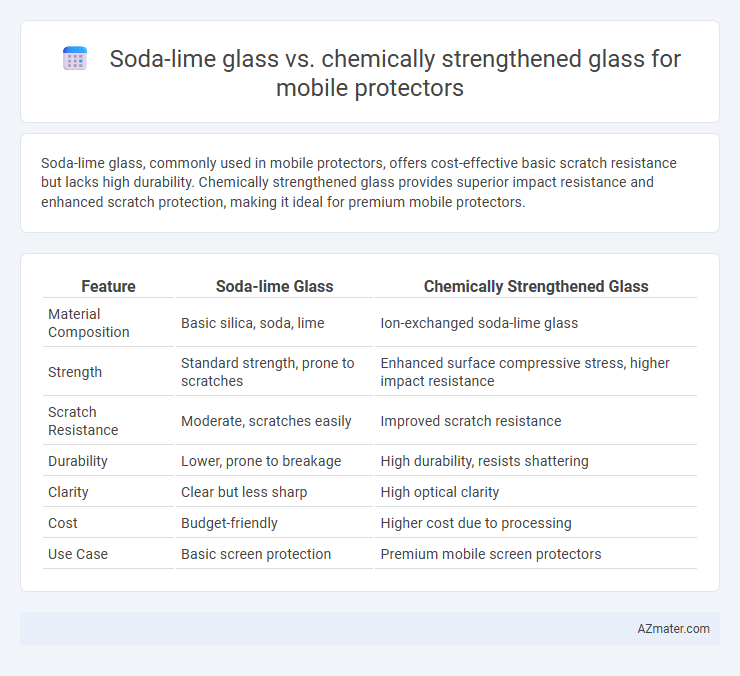Soda-lime glass, commonly used in mobile protectors, offers cost-effective basic scratch resistance but lacks high durability. Chemically strengthened glass provides superior impact resistance and enhanced scratch protection, making it ideal for premium mobile protectors.
Table of Comparison
| Feature | Soda-lime Glass | Chemically Strengthened Glass |
|---|---|---|
| Material Composition | Basic silica, soda, lime | Ion-exchanged soda-lime glass |
| Strength | Standard strength, prone to scratches | Enhanced surface compressive stress, higher impact resistance |
| Scratch Resistance | Moderate, scratches easily | Improved scratch resistance |
| Durability | Lower, prone to breakage | High durability, resists shattering |
| Clarity | Clear but less sharp | High optical clarity |
| Cost | Budget-friendly | Higher cost due to processing |
| Use Case | Basic screen protection | Premium mobile screen protectors |
Introduction to Mobile Screen Protector Materials
Soda-lime glass is a common material for mobile screen protectors, valued for its affordability and basic scratch resistance, but it lacks high durability under impact. Chemically strengthened glass, often made through an ion-exchange process, offers superior toughness and enhanced resistance to scratches and cracks, making it ideal for high-end mobile devices. The choice between these materials impacts the longevity and protective performance of the mobile screen protector.
What is Soda-Lime Glass?
Soda-lime glass, the most common type of glass used in mobile protectors, consists primarily of silica (SiO2), sodium oxide (Na2O), and calcium oxide (CaO), offering affordability and ease of manufacturing. This glass type provides basic scratch resistance and moderate impact protection but lacks the enhanced durability found in chemically strengthened glass. Chemically strengthened glass undergoes an ion-exchange process that replaces smaller ions with larger ones on the surface, significantly increasing toughness and scratch resistance compared to soda-lime glass.
Overview of Chemically Strengthened Glass
Chemically strengthened glass for mobile protectors undergoes an ion-exchange process where smaller sodium ions are replaced by larger potassium ions, creating a compressive stress layer that enhances durability and scratch resistance. This type of glass offers superior toughness compared to traditional soda-lime glass, which is primarily composed of silica, sodium oxide, and calcium oxide but lacks the chemical treatment that improves strength. The improved structural integrity of chemically strengthened glass makes it more effective at absorbing impacts and preventing cracks in mobile screen protectors.
Manufacturing Processes: Soda-Lime vs Chemically Strengthened Glass
Soda-lime glass is produced through a melting process of silica, soda ash, and lime at high temperatures, followed by controlled cooling to form a solid sheet, making it cost-effective but less durable. Chemically strengthened glass undergoes an ion-exchange process where smaller sodium ions in the glass surface are replaced by larger potassium ions in a molten salt bath, producing a compressive stress layer that significantly enhances resistance to scratches and impacts. This ion-exchange method in chemically strengthened glass creates superior strength compared to the thermal tempering of soda-lime glass, making it ideal for high-performance mobile screen protectors.
Hardness and Scratch Resistance Comparison
Soda-lime glass, commonly used in mobile protectors, offers moderate hardness levels around 5 to 6 on the Mohs scale, making it susceptible to scratches from harder materials like metal or sand. Chemically strengthened glass, such as tempered aluminosilicate glass, undergoes an ion-exchange process that significantly enhances surface hardness, often achieving values closer to 7 on the Mohs scale, resulting in superior scratch resistance and durability. This enhanced hardness in chemically strengthened glass provides better protection against everyday abrasion, ensuring longer-lasting clarity and screen integrity for mobile devices.
Durability and Impact Resistance: Which Glass Performs Better?
Chemically strengthened glass offers superior durability and impact resistance compared to soda-lime glass, making it the preferred choice for mobile protectors. The ion-exchange process in chemically strengthened glass creates a compressive stress layer that enhances scratch resistance and reduces the likelihood of shattering upon impact. Soda-lime glass lacks this reinforcement, resulting in lower resilience under drops and collisions.
Clarity and Touch Sensitivity Differences
Soda-lime glass, commonly used for mobile protectors, offers good clarity but often falls short in touch sensitivity compared to chemically strengthened glass. Chemically strengthened glass undergoes an ion-exchange process that enhances surface hardness without compromising optical transparency, resulting in superior clarity and more responsive touch feedback. This advanced treatment also reduces fingerprint smudges, maintaining screen visibility and ensuring a smooth touch experience.
Cost and Availability Analysis
Soda-lime glass is widely used for mobile protectors due to its low cost and high availability, making it the most economically viable option for mass production. Chemically strengthened glass, such as aluminosilicate variants, offers superior scratch resistance and durability but comes at a significantly higher price and is less readily available. Manufacturers targeting premium markets often accept the increased cost and supply constraints associated with chemically strengthened glass to provide enhanced protection and longer product lifespan.
Environmental Impact of Each Glass Type
Soda-lime glass, commonly used in mobile protectors, has a higher environmental footprint due to its energy-intensive production process and limited recyclability compared to chemically strengthened glass. Chemically strengthened glass, made through an ion-exchange process, offers enhanced durability, reducing the frequency of replacements and waste generation. The longer lifespan and potential for recycling of chemically strengthened glass contribute to a lower overall environmental impact in mobile protector applications.
Conclusion: Choosing the Best Glass for Mobile Protection
Soda-lime glass offers affordability and basic scratch resistance, making it suitable for low-cost mobile protectors but lacks durability against impacts. Chemically strengthened glass, through ion exchange processes, provides superior toughness and enhanced resistance to scratches and drops, ensuring prolonged device protection. Opting for chemically strengthened glass maximizes protection and longevity for mobile devices, especially in demanding daily use scenarios.

Infographic: Soda-lime glass vs Chemically strengthened glass for Mobile protector
 azmater.com
azmater.com